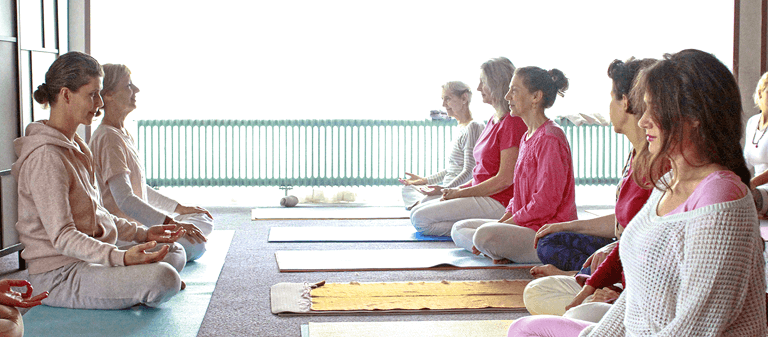Today I want to talk to you about the best-known part of Yoga at least here in the west: the ASANA or the physical postures. These are the best known because they arouse curiosity and also because they are easily photograph(the damage done by Instagram to yoga – the photo you find at the beginning of this post is an example).
However, the Asanas are only a small part of the practice of Yoga and the benefits of the Asanas go beyond the physical advantages that derive from practicing them.
In this post, I put some super basic information that I think you need to know before embarking on your journey in Yoga.
YOGA: BEYOND THE ASANA – THE OTHER BRANCHES
The discipline/philosophy of Yoga includes 8 branches:
- Yama: ethical norms (non-violence, truth, not stealing, moderation, not possession)
- Nyama: rules of behavior (purification, appreciation of what one has, determination, study and self-knowledge, abandonment to what must be)
- Asanas: postures
- Pranayama: breath
- Pratyahara: retraction of the senses
- Dharana: concentration
- Dhyana: meditation
- Samadhy: lighting
(I will dedicate a future post to the description of the various branches)
Unfortunately, in the West, we often focus only on the physical part and experience it as if they were simply a set of gymnastic exercises.
However, Yoga practice goes far beyond the mat: through Yama and Nyama you can bring Yoga into your daily life. Through Pranayama (breath) and Pratyahara (retraction of the senses, concentration on oneself) you can carry out a practice that does not include physical postures at all but that helps you face the days with serenity, determination, enthusiasm, strength.
ASANA: PHYSICAL BENEFITS
A practice of ASANA yoga done well and designed for the constitution and for the strengths. And the weaknesses of each participant is certainly a way to obtain a series of physical benefits.
For this reason, for me, it is important to have in class with a limited number of students: in order to follow them better and to be able to indicate to each one which variations to make in each posture to make the practice beneficial and useful.
A correct Yoga practice, in fact, can help to:
- Reduce stress and all forms of agitation
- Improve sleep quality
- Rebalance the nervous system
- Improve states of muscle tension
- Reduce pain in the spine, back, and cervical area
- Mitigate pain in the abdomen and digestive problems
- Improve thyroid metabolism and female hormones
- Improve blood and lymphatic circulation
- Increase strength and flexibility (which are usually seen as antithetical objectives in the practice of the classic gym)
- … and I could go on
However, as I mentioned before, not all asanas are good for everyone. For this reason, during class practice – and even more individually – I change the postures according to the well-being of the participants. This is important to ensure that, at the end of the practice of Yoga on the mat, you feel well balanced, centered, and rooted.
The sequence of postures in a practice is never random but always has a purpose. A random sequence done alone and repeated for a few days can lead to imbalances both on the physical plane, on the nervous system, and on the subtle plane.
I know something about it: when I started training. I practiced a sequence of postures for more than 45 days that I performed in the morning around 5.30. This practice completely busted my hormonal and stress axis because it was not suitable for my constitution: I starts having a series of cycle disorders, weight changes, nervousness, agitation, etc. To return to feeling good, my teacher advised me to do only Pranayama and Pratyahara exercises for at least a month in the evening.
This is just an example to make you understand how the Asanas should not be seen only as “gymnastics” or physical training.
ASANA: THE MOST IMPORTANT AND DEEP BENEFITS
The practice of Asanas, therefore, cannot be casual. The practice must have a specific purpose. Therefore some postures may have to be compensate for by others or by targeted breathing exercises. Some Asanas can be counterproductive for some goals.
Never choose the asanas by being guide by your ego and thinking something like “how cool, I can do this!”. This is the least Yogic thought that exists.
The Asanas must be expertly mix and calibrates because the practice does not aim only to obtain physical benefits but to create ever greater harmony between body, mind, and soul.
YOGA in fact means union: body, mind, emotions, soul.
ASANA AND LISTENING TO THE BODY
Asanas are use to enter the body. It is not the body that is used to enter the asanas.
Entering the body means using the positions to really listen to the messages. The body transmits to us, understanding our limits, knowing how to stop at the right time. On the contrary, daring when we understand that it is the magic moment to do it.
Precisely for this reason, the Asanas have unusual forms. To allow those who practice them to experiment with different forms and processes that can reveal dormant and hidden potentials or generate new and unknown sensations.
In the beginning, you should not be discouraged if you encounter difficulties, if it is too difficult to perform positions of balance or to stretch or maintain positions of strength.
From the last many years of studying the body, mind, and heart, Adelaide Naturopath Christina is to help you become your healthiest self so that you never have to feel unhappy or frustrated with your weight again. She is a Certified providing many health services, ketogenic diet. she is one of the best dietitian and Keto coach.














